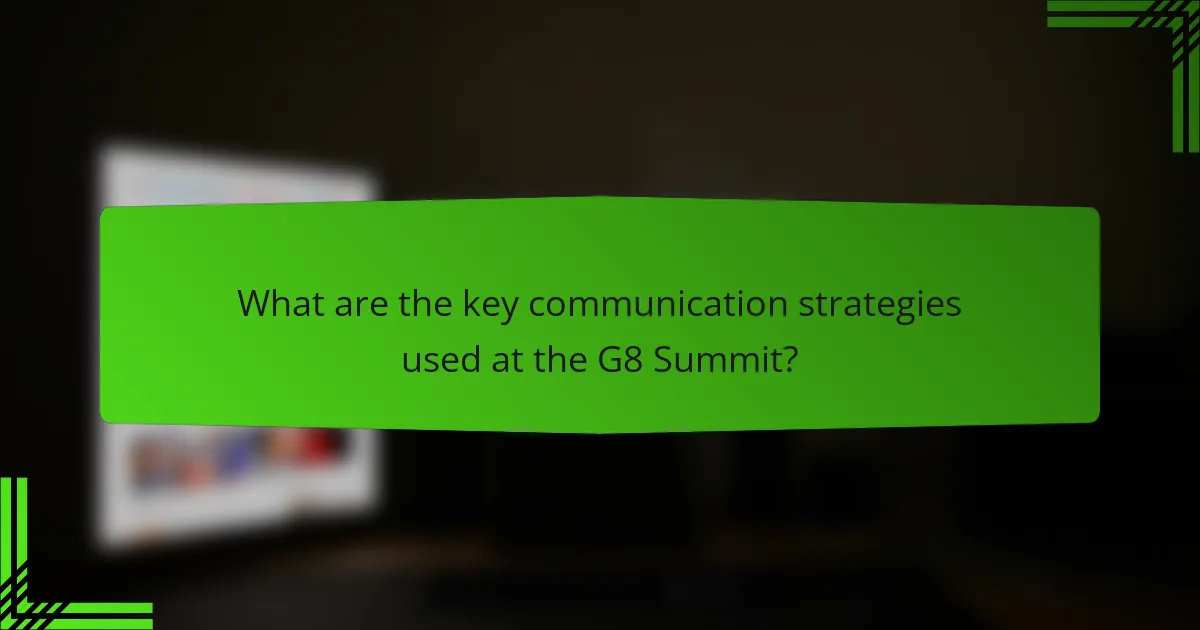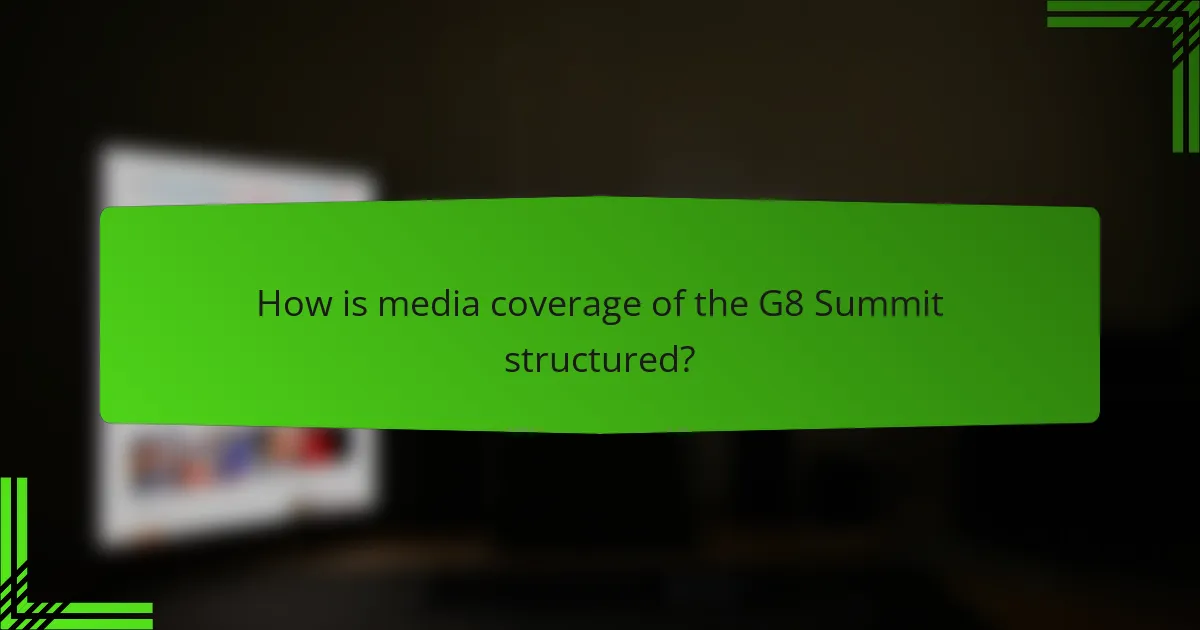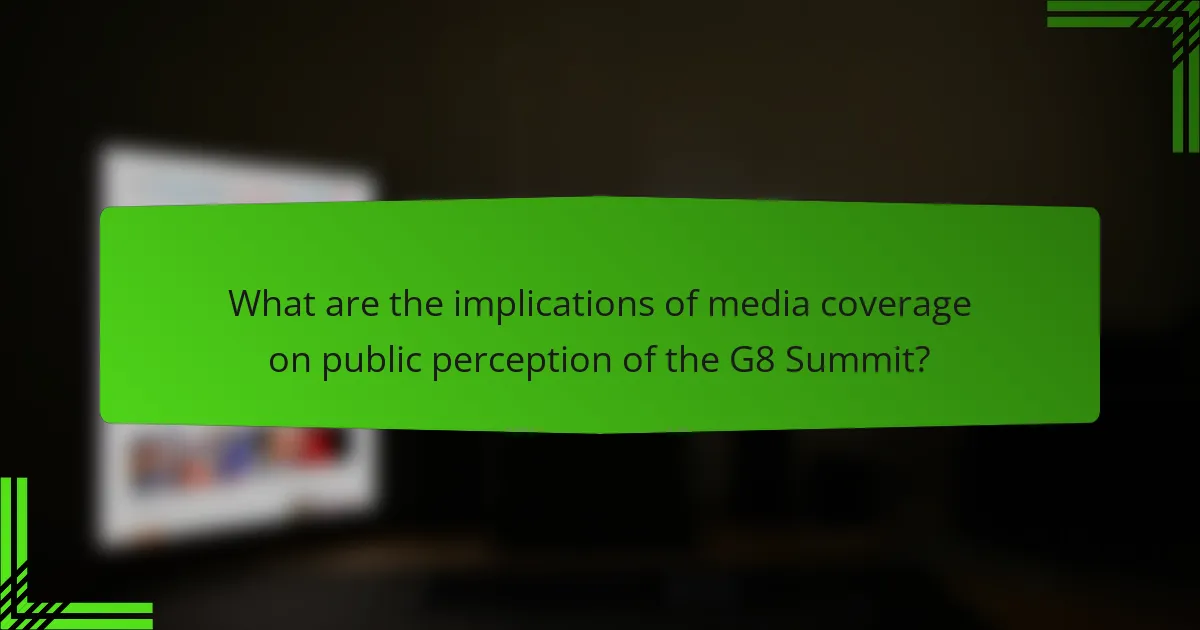The G8 Summit serves as a platform for world leaders to address critical global issues through various communication strategies, including press conferences, official statements, and social media engagement. These methods facilitate direct communication with the media and the public, ensuring transparency and shaping public perception. Media coverage of the summit focuses on key themes such as economic policies, international security, and climate change, providing a structured narrative that influences public opinion and engagement. The portrayal of leaders and the framing of discussions in media reports significantly impact the perceived legitimacy and effectiveness of the summit’s outcomes. Overall, the interplay between communication strategies and media coverage plays a crucial role in informing the public and shaping perceptions of the G8’s initiatives.

What are the key communication strategies used at the G8 Summit?
The key communication strategies used at the G8 Summit include press conferences, official statements, and social media engagement. Press conferences allow leaders to convey their messages directly to the media. Official statements provide formal documentation of agreements and priorities. Social media engagement enhances real-time communication with the public. These strategies aim to ensure transparency and shape public perception. The use of these methods has been critical in framing discussions around global issues. For instance, during the 2013 Summit, leaders utilized Twitter to share updates, increasing public engagement. Overall, these strategies are designed to maximize outreach and foster dialogue among nations.
How do these strategies influence media coverage?
Communication strategies influence media coverage by shaping the narrative around events like the G8 Summit. These strategies include targeted messaging, media engagement, and press releases. Targeted messaging ensures that specific issues are highlighted, guiding media focus. Media engagement fosters relationships with journalists, resulting in favorable coverage. Press releases provide structured information, often leading to more accurate reporting. For example, the 2019 G8 Summit’s communication strategy emphasized climate change, resulting in extensive media coverage of environmental commitments. This alignment between strategy and media coverage can significantly impact public perception and discourse.
What role does messaging play in shaping narratives during the summit?
Messaging plays a crucial role in shaping narratives during the summit. It influences how information is perceived by the public and stakeholders. Clear and consistent messaging can reinforce key themes and objectives of the summit. Effective messaging helps to align various participants’ viewpoints and expectations. It also frames discussions in a way that highlights important issues. For instance, during the G8 Summit, messaging around climate change significantly impacted global policy discussions. Studies have shown that strategic messaging can enhance public engagement and support for summit initiatives.
How do communication strategies vary across different countries participating in the summit?
Communication strategies vary significantly across countries participating in the summit. Each country tailors its approach based on cultural norms and political contexts. For example, Japan emphasizes indirect communication and consensus-building. In contrast, the United States favors direct and assertive messaging.
European nations often prioritize transparency and public engagement in their communication. Countries like Germany focus on factual reporting and data-driven discussions. Meanwhile, nations such as Italy may utilize more emotional appeals in their public messaging.
These variations reflect differing societal values and governance styles. Research indicates that effective communication strategies enhance public perception and engagement during international summits. Understanding these differences is crucial for fostering collaboration and effective dialogue among participating nations.
Why is public perception important in the context of the G8 Summit?
Public perception is crucial in the context of the G8 Summit because it influences the effectiveness of communication strategies. Positive public perception can enhance the legitimacy of the summit’s decisions and initiatives. When the public views the G8 positively, it fosters greater support for policies discussed. Conversely, negative perceptions can lead to public dissent and decreased trust in leaders. Historical examples, such as the 2001 G8 Summit in Genoa, show that negative public sentiment can result in protests and unrest. This highlights the need for effective media coverage to shape public perception favorably. Ultimately, public perception affects the summit’s overall impact and the implementation of its outcomes.
How does media portrayal affect public opinion on summit outcomes?
Media portrayal significantly influences public opinion on summit outcomes. The way media presents information shapes perceptions and attitudes. For instance, positive coverage can enhance public support for decisions made at summits. Conversely, negative portrayals can lead to skepticism and distrust. Studies have shown that framing effects in media can alter how audiences interpret summit results. According to research by the Pew Research Center, 62% of Americans believe media coverage impacts their views on international events. This demonstrates the critical role of media in shaping public discourse surrounding summit outcomes.
What factors contribute to shaping public perception during the summit?
Factors that contribute to shaping public perception during the summit include media coverage, public statements, and social media engagement. Media coverage highlights key discussions and decisions made at the summit. It influences how the public perceives the importance of the issues addressed. Public statements from leaders can sway opinions by framing narratives around specific topics. Social media engagement allows for real-time reactions and discussions among the public. The tone and content of these interactions can significantly impact public sentiment. Additionally, the presence of advocacy groups can shape narratives by providing alternative viewpoints. Research shows that media framing can alter public perception of global issues (Entman, 1993). This illustrates the powerful role that communication strategies play during the summit.

How is media coverage of the G8 Summit structured?
Media coverage of the G8 Summit is structured around key themes and issues discussed at the event. Major news outlets prioritize topics such as economic policies, international security, and climate change. Coverage typically includes live reporting during the summit, expert analysis, and post-summit evaluations. Journalists often focus on the statements made by world leaders and the outcomes of the discussions. Press conferences and official documents are also significant sources of information. The structure aims to provide a comprehensive view of the summit’s impact on global politics. Data from previous summits show that media attention peaks during high-profile announcements. This structured approach helps inform the public and shape perceptions of the G8’s role in addressing global challenges.
What types of media are most influential during the summit?
Traditional media, social media, and digital platforms are the most influential types of media during the summit. Traditional media includes television, radio, and print news outlets. These platforms provide real-time coverage and analysis of summit events. Social media platforms like Twitter and Facebook facilitate immediate public engagement and discourse. Digital platforms, including news websites and blogs, offer in-depth reporting and commentary. Research shows that social media can shape public perception significantly during high-profile events. A study by the Pew Research Center indicates that 62% of adults get news from social media. This demonstrates the growing impact of these media types on public opinion during the summit.
How do traditional media and social media differ in their coverage?
Traditional media and social media differ significantly in their coverage. Traditional media, such as newspapers and television, often provide curated and edited content. This content is typically fact-checked and presented through a formal editorial process. In contrast, social media allows for real-time updates and user-generated content. Information can be shared instantly without extensive editing.
Traditional media coverage is generally more structured and follows journalistic standards. It often includes in-depth analysis and expert opinions. Social media, however, prioritizes immediacy and engagement. It fosters direct interaction between users and content creators.
Furthermore, traditional media reaches a broad audience through established channels. Social media platforms enable targeted outreach based on user preferences and behaviors. This leads to diverse perspectives in social media coverage, which may not always be present in traditional media.
A study by the Pew Research Center indicates that 53% of U.S. adults often get news from social media. This highlights the growing influence of social media on public perception compared to traditional media.
What are the main themes highlighted in media coverage of the summit?
The main themes highlighted in media coverage of the summit include global cooperation, economic policies, and climate change. Media outlets emphasized the importance of nations working together to address pressing issues. Economic discussions focused on trade agreements and financial stability among member countries. Climate change was a significant topic, with calls for sustainable practices and commitments to reduce carbon emissions. Additionally, media coverage often reflected public sentiment towards government actions and international relations. The portrayal of these themes shaped public perception of the summit’s outcomes and effectiveness.
How do journalists approach reporting on the G8 Summit?
Journalists approach reporting on the G8 Summit by focusing on key issues and decisions made during the event. They prioritize coverage of economic policies, international relations, and global security matters. Journalists often conduct interviews with leaders and experts to provide context. They analyze official statements and press releases for accuracy. Many utilize live reporting to deliver real-time updates. Journalists also cover protests and public reactions surrounding the summit. They aim to balance perspectives from various stakeholders. Coverage is typically framed to highlight the summit’s impact on global affairs. This approach ensures comprehensive reporting that informs the public about significant developments.
What challenges do journalists face in covering the summit?
Journalists face several challenges in covering the summit. Access to key events can be restricted, limiting their ability to report accurately. Security measures often hinder movement and create barriers to interviews. Information may be tightly controlled by officials, leading to a lack of transparency. Journalists also encounter intense competition from various media outlets, which can affect the depth of coverage. Additionally, the rapid pace of news cycles requires quick reporting, sometimes at the expense of thorough fact-checking. These factors collectively complicate the journalistic process during high-profile summits like the G8.
How does the selection of sources impact the credibility of summit reporting?
The selection of sources significantly impacts the credibility of summit reporting. Credible sources enhance the reliability of information presented. When reporters use expert opinions, official statements, and verified data, the audience is more likely to trust the report. Conversely, reliance on unverified or biased sources can lead to misinformation. Studies show that media outlets using diverse and reputable sources achieve higher trust ratings. For instance, a report by the Pew Research Center found that audiences perceive news as more credible when it includes multiple perspectives. Ultimately, the choice of sources shapes public perception and influences the overall impact of summit reporting.

What are the implications of media coverage on public perception of the G8 Summit?
Media coverage significantly shapes public perception of the G8 Summit. Positive coverage can enhance the perceived legitimacy and effectiveness of the summit. Conversely, negative coverage may lead to skepticism about the summit’s outcomes and intentions. Studies show that media framing influences public opinions on global issues discussed at the summit. For example, extensive reporting on climate change discussions can increase public awareness and concern about environmental policies. Additionally, the portrayal of leaders during the summit affects their public image. Research indicates that media narratives can sway public support for governmental decisions made during the summit. Thus, the implications of media coverage are profound, impacting both public trust and engagement with G8 initiatives.
How does sensationalism in media affect public trust in the summit?
Sensationalism in media negatively affects public trust in the summit. When media outlets prioritize dramatic headlines over factual reporting, they distort public perception. This can lead to increased skepticism about the summit’s intentions and outcomes. A 2018 study by the Pew Research Center found that sensationalist coverage contributes to a decline in trust in institutions. As a result, audiences may question the legitimacy of the summit’s discussions and decisions. Misinformation can spread rapidly, further eroding confidence. Consequently, public engagement may diminish, impacting the summit’s overall effectiveness.
What are the potential consequences of biased reporting on public perception?
Biased reporting can significantly distort public perception. It can lead to misinformation, where audiences receive incomplete or skewed narratives. This misrepresentation can foster distrust in media outlets. Audiences may develop polarized views on issues, exacerbating societal divisions. Research shows that biased reporting influences public opinion and voting behavior. For example, studies indicate a correlation between media bias and election outcomes. Biased narratives can also shape public attitudes towards political leaders and policies. Overall, the consequences of biased reporting are profound, affecting democracy and civic engagement.
What strategies can be implemented to improve public perception of the G8 Summit?
Engaging the public through transparent communication can improve the perception of the G8 Summit. Utilizing social media platforms for direct interaction fosters a sense of inclusion. Regular updates on summit agendas and outcomes can increase public understanding. Highlighting positive impacts of summit decisions on local communities promotes goodwill. Collaborating with NGOs to showcase grassroots initiatives can enhance credibility. Hosting pre-summit events allows public participation and feedback. Providing accessible information in multiple languages widens outreach. Lastly, addressing criticisms openly shows responsiveness and builds trust.
How can transparency in communication enhance public trust?
Transparency in communication enhances public trust by fostering openness and accountability. When organizations share information clearly, it reduces uncertainty. This clarity helps the public feel informed and valued. Research shows that transparent communication can lead to increased trust levels. For example, a study by the Edelman Trust Barometer found that 81% of people need to trust a brand to buy from them. Furthermore, transparency allows for better engagement and dialogue. It creates a sense of partnership between the entity and the public. This mutual understanding strengthens trust over time. Overall, transparency is a key element in building lasting public trust.
What role do post-summit evaluations play in shaping future perceptions?
Post-summit evaluations significantly influence future perceptions of the G8 Summit. These evaluations assess the effectiveness of communication strategies used during the summit. They identify strengths and weaknesses in media coverage and public engagement. By analyzing participant feedback, organizers can understand public sentiment and concerns. This data informs future summit planning and communication efforts. Historical examples show that evaluations lead to improved transparency and accountability. For instance, post-summit reports from previous years have resulted in enhanced media strategies. Ultimately, these evaluations shape how future summits are perceived by both the media and the public.
What best practices can enhance communication strategies for future G8 Summits?
Enhancing communication strategies for future G8 Summits involves implementing clear messaging, utilizing diverse media channels, and fostering stakeholder engagement. Clear messaging ensures that all participants understand the summit’s objectives. Diverse media channels, including social media, traditional outlets, and live streaming, broaden reach and engagement. Stakeholder engagement, through pre-summit consultations and feedback mechanisms, builds trust and transparency.
Research from the Pew Research Center indicates that effective communication increases public awareness and support for summit initiatives. Additionally, studies show that real-time updates during events improve public perception and engagement. These practices collectively contribute to a more informed and engaged audience, ultimately enhancing the impact of the G8 Summits.
How can stakeholder engagement improve communication effectiveness?
Stakeholder engagement can improve communication effectiveness by fostering collaboration and trust. Engaged stakeholders are more likely to share valuable insights. This can lead to clearer messaging that resonates with diverse audiences. When stakeholders feel involved, they are more inclined to support initiatives. Research shows that organizations with active stakeholder engagement see a 20% improvement in communication outcomes. Effective communication can enhance public perception, especially during high-profile events like the G8 Summit. Additionally, transparent communication builds credibility and reduces misinformation. In summary, stakeholder engagement is crucial for effective communication strategies.
What lessons can be learned from past G8 Summits regarding media relations?
Past G8 Summits reveal important lessons about media relations. Effective communication strategies are crucial for managing public perception. Transparency in decision-making fosters trust among journalists and the public. Timely press releases can shape narratives positively. Engaging with media proactively helps counter misinformation. Consistent messaging across platforms enhances credibility. Addressing controversies directly can mitigate negative coverage. Collaboration with media outlets can facilitate better reporting.
The main entity of the article is the G8 Summit, focusing on its communication strategies, media coverage, and public perception. The article outlines key communication methods employed during the summit, including press conferences, official statements, and social media engagement, and discusses how these strategies shape media narratives and influence public opinion. It also examines the varying communication approaches across participating countries and emphasizes the importance of public perception in determining the effectiveness of summit initiatives. Additionally, the article highlights the implications of media portrayal on public trust and suggests best practices for enhancing communication strategies in future summits.